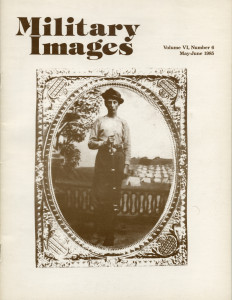The complete issue
Vol. VI, No. 6
(32 pages)
Print edition: Visit our store to check availability
Digital edition: Visit JSTOR.org to purchase
Subscribe to MI
Explore the MI Archives: Browse | Advanced search | Tutorial
Inside
Cover image
A young sharpshooter graces the cover of this issue of Military Images.
Editor’s Desk (p. 1)
A change in computer systems has led to a change in subscription codes for renewal. A listing of old and new codes is provided to allow subscribers to understand when to renew. The editor is also pleased to note that a new subscriber in Hong Kong means that Military Images has readers on all continents. He warns also that fake tintypes and cartes de visite are still showing up, and asks for readers to let the magazine know so readers are aware of who is selling them. More material from the Confederate states is also coming in, meaning more articles and vignettes from the South.
Mail Call (pp. 3-4)
The letters to the editor include a lengthy response from a reenactment group in Bristol, U.K., requesting information on the uniforms and flags of the Irish Brigade. Other notices include the offer of a research stipend, the theft of an 1852 pattern Union naval officer’s sword from Kennesaw, Georgia, and details on some of the fake images being sold by dealers.
Passing in Review (p. 5)
Three volumes are presented for review in this issues. First is Civil War Monitor, a publication that provides abstracts and an index of articles. This is a bimonthly publication edited by Joseph L. Harsh of George Mason University, and may be a helpful resource for serious researchers. Second is Army Uniforms of World War I by Andrew Mollo, which is a handbook complete with color plates and descriptions of uniforms from 16 nations engaged in World War I. The only units missing are colonial troops and volunteer organizations. Third is Militaria Magazine, a bimonthly publication in French and emphasizes World War II. The images are of high quality, and would be of interest to those readers with an interest in that era of conflict.
Georgians in Gray: A Series of Vignettes by Keith Bohannon (pp. 6-13)
Ten different images are featured in this pictorial article. Each image tells a story of a Georgia soldier, such as the three Chitwood brothers who enlisted in the “Bartow County Yankee Killers” which became Company A of the 23rd Georgia Infantry. The vignette about Pvt. William C. Bradley includes the text of a letter written home in April 1862, describing his experience early on at Yorktown, Virginia. Each story illustrates a different experience of these soldiers from Georgia.
The Saucy Battery: History of the 10th Massachusetts Light Artillery by Philip Katcher (pp. 14-15)
Led by Captain J. Henry Sleeper, the article describes the service of the 10th Massachusetts Light Artillery from its arrival in Washington for training in October 1862. Having missed the large battles at Chancellorsville and Gettysburg while chasing after John S. Mosby’s rangers from their post across the Potomac at Edward’s Ford, the unit was finally on the move in time for Auburn, Virginia in October. Moved into the II Corps under Winfield Hancock when the III Corps disbanded, they 10th was able to keep its old corps badges as it crossed the Rapidan River in early May 1864. They fought well in the Wilderness at the Battle of Cold Harbor, and Capt. Sleeper was mentioned in the New York Evening Post for his leadership there; the article also noted the 10th was known as the “saucy battery” in the II Corps. They remained in action until Appomattox, and took part in the Grand Review of the Army.
The Blue and Gray by Albert W. Haarmann (pp. 16-23)
Subtitled “… and the Green and the Black and the Red, etc.” this survey of newspapers announcing the arrivals of Union volunteer troops in Washington, D.C. Seventeen photographs of these uniforms are included to illustrate the many units which arrived between April and July of 1861. It is interesting to note how many volunteer regiments arrived wearing gray, such as all six of the Maine units that arrived at that time.
The Excelsior Banner by Randy Beck (p. 24)
Louisville, Kentucky was the site of a drill competition between the regiments of the 4th Division, 15th Army Corps as they waited for the end of their service in June 1865. The regiments of each of the three brigades would compete with one another, with the winners of each brigade competition vying to win a $300 silk banner. Colonel William Hanna of the 50th Illinois in the Third Brigade cancelled all leave and continually drilled his men, eventually meeting the 7th Iowa (1st Brigade) and the 63rd Illinois (2nd Brigade) for the final competition. Named “The Excelsior” banner after the competition, Col. Hanna returned home with the banner and had the carte de visite featured in the article taken in Quincy, Illinois.
The 13th Shot: Tragedy Aboard the U.S.S. Iowa by William Christen (pp.25-17)
Known for having fired the initial shots at Spanish vessels during the Spanish American War in 1898, the U.S.S. Iowa was taking part in targeting drill off the coast of Pensacola, Florida on April 9, 1903 when an unexpected tragedy struck. During the firing of the 13th shot that morning, the barrel of the port 12-inch gun sheared off, crashing through the deck, and killing three sailors three decks below. A few images of the Iowa are included with the article, but others are requested by the author.
Sergeant Andrew R. Denton: Vignette of the 43rd Tennessee, C.S.A. by Terri N. McGinnis (p. 28)
The couple featured with this article, Sgt. Denton and his bride, Martha, were wed on January 4, 1862, shortly after his enlistment in Company G of the 43rd Tennessee. He was elected to First Sergeant in May of 1862, and took part in the fighting around Vicksburg in 1863. It was on June 22, 1863 that Denton was wounded, dying of blood poisoning a few days later. His only child was born four and a half months later.
Stragglers (pp. 29-30)
Space allows only one image in the “Stragglers” feature in this issue. The antebellum image shows an unidentified group of men probably belonging to a target club. These were civilian clubs similar to the German Schutzenverien, which wore uniforms and practiced drill despite the fact that they were not associated with official militia. Although these groups existed after the Civil War, they were more like social clubs, rather than focusing on marksmanship.
Back Image
The American cruiser, U.S.S. Olympia, Admiral Dewey’s flagship, in harbor, Venice, Italy.





































